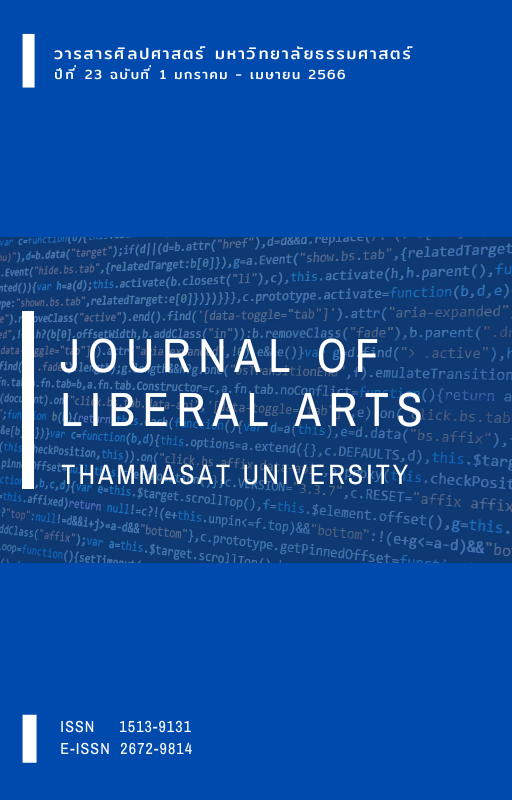Getting the Bugs Out in Kampoon Boontawee’s A Child of the Northeast
Main Article Content
บทคัดย่อ
This study discusses the wild insects hunted and eaten by the protagonist Koon, the boy in Boontawee’s A Child of the Northeast and explains how he learns to hunt and eat them. It also presents the states of finding and consuming the tiny insects which reflect human kinship. Theoretical ideas regarding kinship stated by Robin Fox and other researchers are focused on. The qualitative method is employed; the findings are reported in the form of a descriptive analysis. The study finds that mainly three types of wild insects are hunted. The boy learns how to find cicadas from his father. He learns how to find crickets from his mother. Eventually, he learns how to get red ants’ eggs from his father and neighbors. All are done under the mode of simplicity with a moderate sense while human kinship can be seen. Edible wild insects, including wild animals and plants, play a part in becoming locals living a traditional lifestyle within nature. The study argues that the wilderness can bring a family and its friends together as a single community.
Downloads
Article Details

อนุญาตภายใต้เงื่อนไข Creative Commons Attribution-NonCommercial-NoDerivatives 4.0 International License.
เอกสารอ้างอิง
Boontawee, K. (2005). A Child of the Northeast (S. F. Kepner, Trans.). Pouyzian. (Original work published 1976)
Carsten, J. (1995). The substance of kinship and the heat of the hearth: Feeding, personhood, and relatedness among Malays in Pulau Langkawi. American Ethnologist, 22(2), 223-241. http://www.jstor.org/stable/646700
Chuenpraphanusorn, T. (2014). The relevance of the philosophy of sufficiency economy and ecological awareness in the two novels, ‘The Good Earth of Pearl S. Buck and A Child of the Northeast of Khamphoon Boonthawee. https://ssrn.com/abstract=2380512
Harianja, R. F., & Sudrajat, A. (2021). The local wisdom of Batak Toba through the philosophy of Dalihan Na Tolu in a kinship environment. Budapest International Research and Critics in Linguistics and Education (BirLE) Journal, 4(2), 759-765. https://doi.org/10.33258/birle.v4i2.1838
Huis, A. V. (2013). Edible insects: Future prospects for food and feed security. Food and Agriculture Organization of the United Nations. https://library.wur.nl/WebQuery/wurpubs/fulltext/258042
Jaban, A. (2013). The boy Koon who likes to ask: Identities of Isan locals and region in a short story a child of the northeast (Dek Koon phoo chop songsai attalak khong kon Isan attalak thin Isan nai rueng san Luk Isan). http://ariyapronjaban132536.blogspot.com/2013/10/blog-post_5032.html
Kepner, S. F. (2005). Introduction. In K. Boontawee (Ed.), A Child of the Northeast (pp. 5-13). Pouyzian.
Kuper, A. (2018a). We need to talk about kinship. Anthropology of This Century, 23. http://aotcpress.com/articles/talk-kinship/
Kuper, A. (2018b). Anthropology: Scope of the discipline. The International Encyclopedia of Anthropology, 1-25. https://doi.org/10.1002/9781118924396.wbiea1591
Lao, R., Parks, T. I., Sangvirojkul, C., Lek-Uthai, A., Pathanasethpong, A., Arporniem, P., Takkhin, T., & Tiamsai, K. (2019). Thailand’s inequality: Myths & reality of Isan. https://think-asia.org/handle/11540/10500
Morris, B. (2004). Insects and human life. Routledge.
Prachakul, N. (2009). What is there in a child of the northeast? (Mee arai nai Luk Isan). In The Rethinking Volume 1 (York Aksorn Yorn Kwarmkit. Volume 1, pp. 43-50). Arn.
Prasansak, R. (2020). A distant reading of Khamphun Bunthawi’s Luk Isan (A Child of the Northeast) as world literature. Journal of Letters, 49(2), 1-20.
Read, D. W. (2016). How culture makes us human : primate social evolution and the formation of human societies. Routledge.
Ryan, J. C. (2020). Plants, people and narratives in southeast Asia: Reading Kampoon Boontawee’s a child of the northeast as literary ethnobotany. http://ijoch.com/wp-content/uploads/2020/06/RYAN-John-Plants-People-Narratives-x-1.pdf
Suwanmontri, C., & Kawashima, H. (2016). Provincial migration and agricultural population change in Thailand. Journal of Agriculture, 32(1), 39-49.
Wathasit, Y. (2015). A Child of the Northeast: The S.E.A. Write literary work reflecting true Isan society and lifestyle (Luk Isan wannakam S.E.A Write sathornphap sangkhom withee sheewit khong shaw Isan khanantha). http:// yupaporn-wathasit.blogspot.com/2015/0


